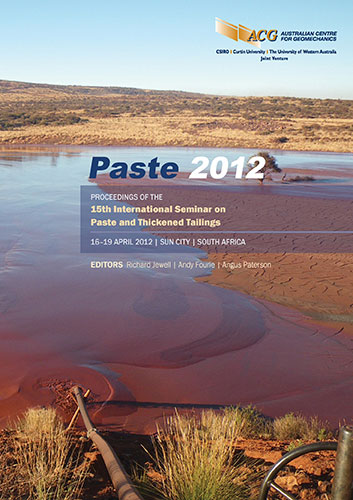The effects of synthetic flocculants on some geotechnical properties of kaolin clay

|
Authors: Reid, D; Fourie, AB |
DOI https://doi.org/10.36487/ACG_rep/1263_14_Reid
Cite As:
Reid, D & Fourie, AB 2012, 'The effects of synthetic flocculants on some geotechnical properties of kaolin clay', in R Jewell, AB Fourie & A Paterson (eds), Paste 2012: Proceedings of the 15th International Seminar on Paste and Thickened Tailings, Australian Centre for Geomechanics, Perth, pp. 157-167, https://doi.org/10.36487/ACG_rep/1263_14_Reid
Abstract:
Synthetic flocculants have been used for decades in the mining industry, particularly in solid liquid separation related to thickening. Recently, the use of these chemicals to achieve improved depositional behaviour of tailings has been trialled, and implemented at a small number of mine sites. In these early attempts, flocculant addition just prior to deposition has improved the dewatering of deposited tailings and resulted in a steeper beaching angle. This has the potential to reduce capital and operating costs for tailings management if implemented correctly. While this is a promising new technology, very little research is available on the impact of flocculants on a number of important geotechnical parameters. An experimental programme has commenced to quantify these impacts. The increased settling rate of flocculated material provides implicit evidence of the increased apparent particle size resulting from this process. However, this increase in apparent particle size is known to be sensitive to shearing and other effects. Therefore, it is possible that sufficient confining pressures or shear would quickly break down the flocculated particles, making the geotechnical behaviour of a material indistinguishable whether flocculated or not. However, little evidence exists to support or disprove this hypothesis. Preliminary results from a laboratory testing programme to determine consolidation properties and particle size distribution for kaolin with, and without, flocculant addition are presented. Unique sample preparation methods have been utilised in an attempt to isolate the effects of flocculant addition. Initial results indicate that the effects of flocculant addition are not noticeable upon application of relatively small effective stresses to the samples. Further laboratory testing is required to assess if this conclusion can be extended to a variety of other tailings, flocculants, and resulting geotechnical properties.
References:
Alam, N., Ozdemir, O., Hampton, M.A. and Nguyen, A.V. (2010) Dewatering of coal plant tailings: Flocculation followed by filtration, Fuel, Vol. 90, pp. 26–35.
Brumby, M., Brough, J. and Flanagan, I. (2008) RheomaxTM Modified Tailings Disposal at Welbeck Colliery’, in Proceedings of the Eleventh International Seminar on Paste and Thickened Tailings (Paste 2008), A.B. Fourie, R.J. Jewell, P. Slatter and A. Paterson (eds), 5–9 May 2008, Kasane, Botswana, Australian Centre for Geomechanics, Perth, pp. 199–210.
da Silva, F. (2010) Reducing risks to tailings storage facilities through in-line flocculant addition, unpublished.
Daubermann, R. and Földvári, Z. (2009) Evaluation of Ciba® RheomaxTM Chemical Technology on Ferrochrome Deposits in Concrete-Lined Tailings Dams, in Proceedings of the Twelfth International Seminar on Paste and Thickened Tailings, R.J. Jewell, A.B. Fourie, S. Barrera and J. Wiertz (eds), April 2009, Vina del Mar, Chile, Australian Centre for Geomechanics.
Head, K.H. (1992) Manual of Soil Laboratory Testing Volume 3: Effective Stress Tests, Second Edition, John Wiley & Sons Chichester, 428 p.
Ishihara, K. (1985) Stability of natural deposits during earthquakes, in Proceedings from the 11th International Conference on Soil and Mechanics and Foundation Engineering, San Francisco, Balkema, Vol. 1, pp. 321–376.
Jefferies, M.G. and Been, K. (2000) Implications for critical state theory from isotropic compressions tests of sand, Geotechnique ICE, Vol. 50, pp. 419–429.
Lehane, B.M., O’Loughlin, C.D., Gaudin, C. and Randolph, M.F. (2009) Rate effects on penetrometer resistance in kaolin, Geotechnique, Vol. 59, pp. 41–52.
Li, A.L., Ritchie, D., Welch, D. and Been, K. (2009) Stability of Large Thickened, Non-Segregated Tailings Slopes, in Proceedings of the 12th International Seminar on Paste and Thickened Tailings (Paste2009), R.J. Jewell, A.B. Fourie, S. Barrera and J. Wiertz (eds), April 2009, Vina del Mar, Chile, Australian Centre for Geomechanics, Perth, pp. 301–311.
Lu, N., Ristow, G.H. and Likos, W.J. (2000) The accuracy of hydrometer analysis for fine-grained clay particles, Geotechnical Testing Journal, ASTM, Vol. 23, pp. 487–495.
Mitchell, J.K. and Soga, K. (2005) Fundamentals of Soil Behaviour, John Wiley and Sons, New York, 577 p.
Sachan, A. and Penumadu, D. (2007) Effect of microfabric on shear behaviour of kaolin clay, Journal of Geotechnical and Geoenvironmental Engineering, ASCE, Vol. 133, pp. 306–318.
Stewart, D.P. (1990) Lateral loading of piles in soft clay due to nearby embankment construction, Research report GEO: 90086, Department of Civil and Resource Engineering, the University of Western Australia.
Stocks, P. and Parker, K. (2006) Reagents, in Paste and Thickened Tailings – A Guide, R.J. Jewell and A.B Fourie (eds), Australian Centre for Geomechanics, Ch. 6, pp. 79–90.
USNRC (1985) Liquefaction of soils during earthquakes. National Academy Press, Washington DC.
Wells, P.S., Revington, A. and Omotoso, O. (2011) Mature fine tailings drying – technology update, in Proceedings of the 14th International Seminar on Paste and Thickened Tailings (Paste2011), R.J. Jewell and A.B. Fourie (eds), 5–7 April, Perth, Australia, Australian Centre for Geomechanics, pp. 155–166.
© Copyright 2025, Australian Centre for Geomechanics (ACG), The University of Western Australia. All rights reserved.
View copyright/legal information
Please direct any queries or error reports to repository-acg@uwa.edu.au
View copyright/legal information
Please direct any queries or error reports to repository-acg@uwa.edu.au